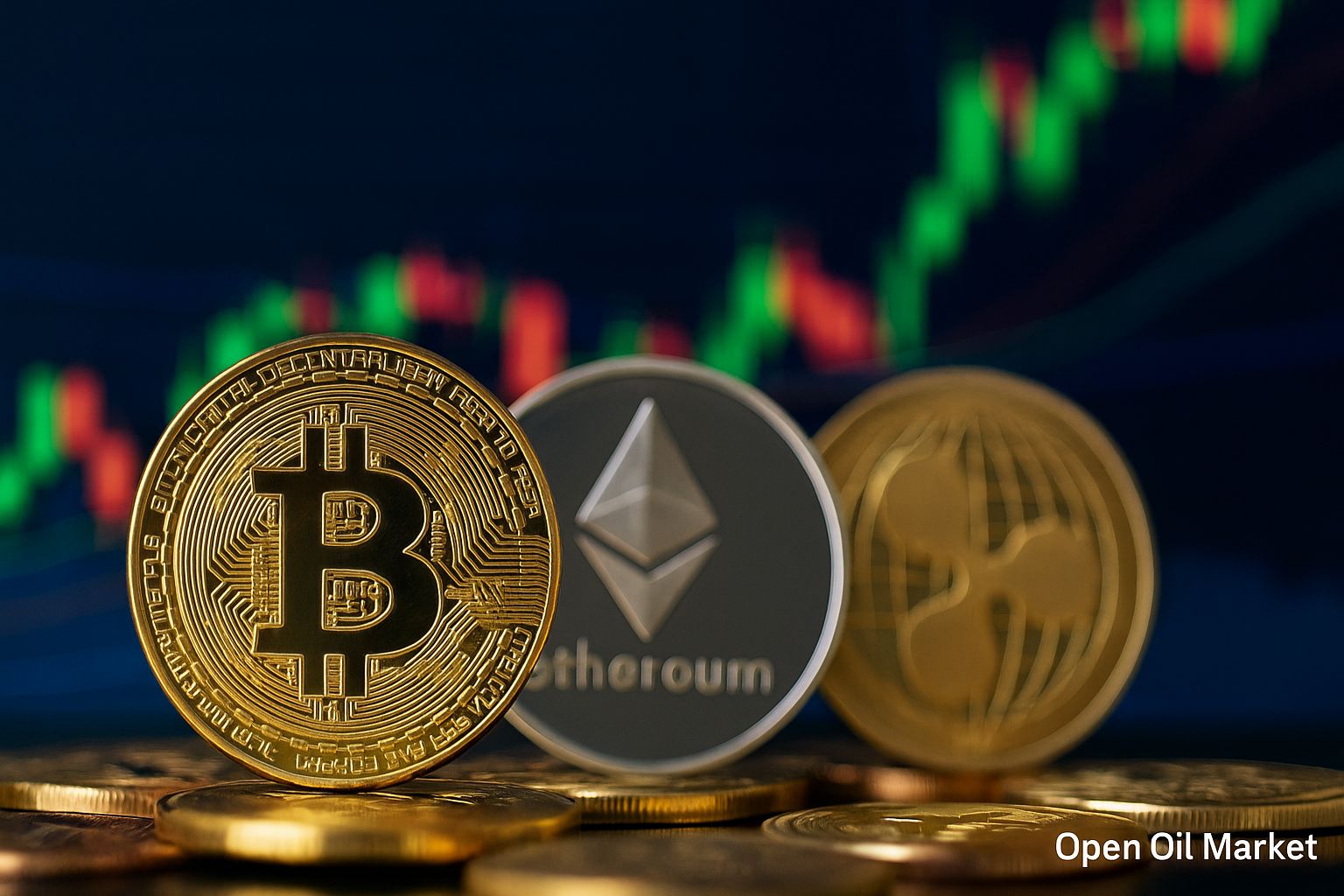
Current Cryptocurrency News as of August 8, 2025: Bitcoin and Ethereum Strengthen, Institutional Investors Expand Participation, Market Gains New Momentum. Overview of the Top 10 Cryptocurrencies, Regulatory Initiatives, and Prospects.
The cryptocurrency market is showing signs of revival after a period of consolidation, driven by positive signals. Investors are balancing caution with moderate optimism in light of improved regulatory clarity and increased participation from major players. The focus remains on the resilient positions of Bitcoin and Ethereum, heightened activity among institutional investors (ETFs, corporate investments), and new regulatory steps shaping the market landscape as of August 8, 2025.
Cryptocurrency Market: Gradual Revival Amid Positive Signals
Following a recent correction, the cryptocurrency market demonstrates moderate growth. Bitcoin and leading altcoins are trading close to their peaks despite occasional profit-taking. The total market capitalization remains above $3.7 trillion with little volatility. Minor pullbacks after a rapid rally are perceived as a healthy pause, strengthening the foundation for a new wave of growth.
The macroeconomic environment remains relatively favorable. The US Federal Reserve has kept the base rate unchanged, and an unexpected vote by several members in favor of a rate cut has bolstered hopes for policy easing by fall. Global markets are closely watching inflation data and the upcoming Fed symposium in Jackson Hole — these events may temporarily increase volatility. However, the absence of negative surprises from central banks supports interest in risk assets, including cryptocurrencies. The market is exhibiting rare stability, indicating its maturation and the growing role of institutional capital.
Bitcoin: Holding Positions Amid Cautious Growth
The first cryptocurrency is maintaining a narrow range around recent peak values. In July, Bitcoin reached a historic high of over $120,000 and stabilized in the mid-$110,000 corridor. Some traders took profits at the psychological level of $120,000, but long-term holders maintained their positions; blockchain data shows that large "whales" only partially took profits at peaks while continuing to accumulate BTC.
Experts note that the limited supply of BTC and capital inflow from companies and funds are forming a sustainable bullish trend in the long term. Several Wall Street analysts forecast that, under favorable macroeconomic conditions, Bitcoin could reach new record highs by the end of the year. In the short term, the current pause provides the market with a breather before a potential new surge, although the risk of sudden pullbacks remains.
Ethereum: Growth Potential and Staking Advantages
Ethereum (ETH), the second-largest crypto asset by market capitalization, remains close to recent highs. Last month, Ether surpassed $3,500 (for the first time since spring), approaching the $4,000 mark, but due to partial profit-taking, it was unable to maintain that level immediately. The fundamental outlook for ETH remains strong, driven by growing institutional interest and the potential for staking. ETH holders receive annual yields of approximately 3-5% by participating in the network, attracting large players and corporations. Ethereum serves as the foundational platform for numerous DeFi and NFT projects, leading many companies to accumulate it in their reserves. Despite volatility, Ether is considered an asset with enormous technological potential.
XRP: Multi-Year Highs and New Benchmarks
The XRP token (Ripple) is among the market leaders, recently reaching price levels not seen since late 2018. This surge was fueled by significant legal victories for Ripple: a US court confirmed that secondary sales of XRP do not constitute securities, alleviating substantial regulatory risks. The final resolution in the dispute with the SEC is still pending (the regulator's appeal remains), but market sentiment is positive. If the Securities and Exchange Commission (SEC) officially drops its claims in the coming weeks, the long-standing uncertainty regarding XRP's status will fade.
Additional momentum for XRP may come from the launch of new investment products. The SEC's softened stance has opened the door to ETFs for major altcoins, including XRP. Analysts believe that the first such ETFs could be launched this fall pending regulatory approval. This trend is also supported by news from abroad: Japanese company SBI Holdings has applied for a combined ETF for Bitcoin and XRP. Thus, XRP is at a turning point: legal clarity and the launch of ETFs could provide it with new growth momentum, while prolonging decisions would dampen investor enthusiasm. Meanwhile, institutional interest in XRP remains strong — major players view it as a promising tool for diversification.
Other Leading Altcoins: Mixed Dynamics
- Binance Coin (BNB): The native token of the largest cryptocurrency exchange Binance maintains a high market capitalization. BNB shows stability amid an overall wait-and-see market, although the Binance ecosystem is under close regulatory scrutiny. The coin is widely used for transaction fees and in DeFi projects on the Binance Smart Chain, supporting demand.
- Cardano (ADA): The smart contract platform with a scientific approach exhibits restrained dynamics. ADA remains in the top 10 due to a strong community and regular network updates (recent upgrades enhance blockchain scalability and functionality). Investors view Cardano as a long-term project, although short-term price volatility persists.
- Solana (SOL): The high-speed blockchain, which faced significant challenges in 2022-2023, has managed to regain the trust of some investors. SOL ranks among the largest altcoins, and its technology is attracting the attention of traditional businesses — for instance, Visa has added support for Solana for stablecoin payments. If crypto-ETFs are approved in the US, Solana is expected to receive additional capital inflows.
- Dogecoin (DOGE): The most well-known meme cryptocurrency remains in the top 10, although its price has been relatively stable lately. DOGE price movements are still influenced by community sentiments and media mentions. The inflationary issuance model limits long-term price growth, but the coin remains a popular "gateway" asset for newcomers and is the subject of speculation during news hype surges.
Regulation: Initiatives in the US, Asia, and Europe
- US: President Donald Trump is preparing to sign executive orders prohibiting banks from "debanking" crypto firms and allowing the inclusion of crypto assets (such as Bitcoin) in 401(k) retirement plans. Simultaneously, the SEC has stated that certain forms of "liquid staking" do not fall under securities laws, partially removing regulatory uncertainty. These measures demonstrate the US's desire to support innovation while maintaining risk control.
- Hong Kong: As of August 1, mandatory licensing for stablecoin issuers has been introduced, overseen by the Hong Kong Monetary Authority (HKMA). Issuing companies must maintain a 100% reserve for the tokens they issue and report regularly — a framework designed to protect investors. Hong Kong is strengthening its position as a crypto hub in Asia, offering clear rules for the industry.
- European Union: The EU has commenced the phased implementation of the MiCA (Markets in Crypto-Assets) regulation, which standardizes the rules for cryptocurrency and stablecoin circulation across eurozone countries. MiCA mandates registration and disclosure requirements for crypto companies. The first licenses under the new rules are expected in 2024 — this will enhance market transparency and facilitate the integration of cryptocurrencies into Europe's financial system.
Traditional Business and Finance: Integration with Cryptocurrencies
- JPMorgan: The largest bank in the US is deepening its involvement in the crypto economy. JPMorgan has launched a blockchain platform for settlements and has partnered with exchange Coinbase, which will soon allow bank clients to purchase cryptocurrencies directly. These steps illustrate how traditional banks are integrating digital assets into their infrastructure.
- PayPal: The payment giant is introducing cryptocurrencies into online transactions. The company has launched the Pay with Crypto service, allowing merchants to accept payments in over 100 cryptocurrencies with instant conversion to fiat via the PYUSD stablecoin. This initiative simplifies global trade and encourages businesses to more actively utilize crypto payments.
- Other Industries: Crypto initiatives are also impacting traditional businesses beyond the finance sector. An American electronics manufacturer has invested heavily in BNB tokens for its treasury, while a pharmaceutical company has invested in Litecoin. The British oil and gas firm Union Jack Oil plans to use excess gas for Bitcoin mining to monetize resources. Such steps legitimize cryptocurrencies in the eyes of traditional companies and create additional market demand.
Market Prospects: Investor Expectations
The beginning of August has been marked by relative calm in the cryptocurrency market, but ahead are a number of drivers capable of setting a new direction for trends. Analysts view the current pause as technical: profit-taking after the rally has allowed the market to cool down, and such a breather typically precedes the next growth phase. If the global economy continues to signal positively — slowing inflation, softer central bank rhetoric — investors may more actively return to risk assets, including cryptocurrencies.
Industry events will also play a role. The potential removal of uncertainty surrounding XRP, the launch of the first ETFs on major altcoins (Solana, XRP, etc.), and the long-awaited approval of spot Bitcoin ETFs in the US — all of this, combined with the implementation of new institutional projects (crypto funds, stablecoin issuance by banks), could bolster trust in the market. In a favorable scenario, experts do not rule out that by the end of 2025, Bitcoin and several leading altcoins may reach new historical highs. However, at present, many participants are adopting a wait-and-see approach — the market is consolidating, even though fundamental growth factors remain intact.




